ABSTRACT
Based on a case study of cassava analysis, this study described food loss along the cassava supply chain. Overall food loss in Thailand at the processing level was very limited. In addition, the electricity generation and biofuel produced from biogas from the cassava and starch factory have shown a good example of circular economy practice. However, physical loss mainly occurred at farm level and on farm loss due to breaking the cassava tuber from digging machine or the delay of collecting the fresh cassava root at the farmers' plots causing damaged of fresh cassava root. Despite, in the cassava starch processing it generated a large volume of waste from peeling and adhering dirt from the initial processing, and a large volume of liquid wastes from root washing and starch extraction process. The cost of treatment and disposal of these wastes and residues bring a huge financial burden to the cassava starch processing factory. Therefore, turning waste to environmental and economic value product can make the cassava starch processing plant to be sustainably and create economic value. In addition, the electricity generation and biofuel produced from biogas have shown a representativeness and are sustainable opportunities to encouraging or increasing the use of cassava circular economy practices.
Keywords: Food Loss, Circular Economy, Cassava, Thailand
INTRODUCTION
From the past to the present, the world population has been growing steadily and, in the future, it is projected to increase from approximately 7.6 billion in 2017 to 8.6 billion in 2030 and to 9.8 billion in 2050 (United Nations, 2017). Due to the rise of the world population, coupled with a forecast of global economic growth of 2.9 % per year, the forecast is that the world will have to produce more than 70 % of food in 2050 (FAO, 2019). Although technology has made great advances and helped the world to produce more food; however, according to global food loss and waste (FLW) study of FAO, it is founded that about one-third of the world’s food produced for human consumption is lost and wasted globally, which amounts to 1.3 billion tons per annum. The high-income countries and the middle to low income countries account for 670 and 630 million tons of food wastes and disposed per annum, respectively. Based on existing data and peer-reviewed literature also showed that FLW has the related environmental, social and economic impacts and the scale of FLW throughout the food value chain is analyzed from agricultural production down to household consumption and disposal. Food loss and waste in economic context represents a waste of resources used in each production stage, and it also contributes to unnecessary increase of greenhouse gas (GHG) emissions. FAO indicated that FLW generated GHG of 3.3 gigatons of carbon dioxide equivalent (FAO, 2014). This food wastage and disposal will not only lead to undermine the sufficiency of food for the world population in the future but also has a negative impact on the limited resource utilization for food production and environment.
The Food and Agriculture Organization (FAO) of the United Nations estimates that more than 40 % of all food losses in developing countries occur in food production period (Pre-Harvest Level), the post-harvest period (Post-Harvest Level) and in processing (Processing Level) while in developed countries, food wastage often occurs during retail and when food reaches consumers (FAO, 2011; 2019). In Southeast Asia, the Institution of Mechanical Engineers (2013) estimated that losses from rice production could be as high as 37-60%. While the study of Parfitt, Barthel and Macnaughton (2010) indicated that the minimum waste from rice production in Asia is between 13% and15%. For fruits and vegetables, FAO found that losses in developing countries, including Southeast Asia, are most likely to occur in pre-harvest and post-harvest production, accounting for 16 % and 19 %, respectively. Throughout the food chain of fruits and vegetables, more than 50 % of the total loss of the product had been produced (FAO, 2011). In Thailand, the Office of Agricultural Economics (2015) analyzed food wastage and discarding of fresh vegetables and found that there was 15% loss before harvest, 9% loss of post-harvest, and 25% loss of processing and packaging during distribution and trade. Kummu et al. (2012) estimates that an estimated 1 billion people who are starving will consume more food if our planet can reduce half of food crop production loss.
This paper provides insights into key concepts around FLW of cassava and highlights the scale of the problem at a farm and regional level. It also reflects on the main challenges for implementing strategies to reduce FL and the implications for policymaking.
DEFFINITIONS OF FLW IN AGRICULTURE
The terms “food loss” and “food waste” are commonly used to describe total losses and waste within the different steps of the food supply chain (FSC) from production (pre-harvest), postharvest, processing to distribution and consumption. However, there is no single definition of food loss (FL) and food waste (FW). Various stakeholders in global food systems use many definitions and terminologies due to different goals for quantifying FLW (HLPE, 2014, Buzby et al., 2015; Food and Agriculture Organization, 2015). Terminologies of FLW can be diversified in terms of scope (intended for human consumption or not), timing (pre-harvested, harvesting, post-harvested), criterion (utilization, edibility or nutrition), perspective (environmental, social, food security), and type (quality or quantity of food) (Lundqvist, de Fraiture et al. (2008), BCFN (2012), Chaboud and Benoit (2017). Food and Agriculture Organization (2019) defined FL as the decrease in the quantity or quality of food caused by the decisions and actions of food operators throughout the food supply chain from harvesting/slaughter/capture to retail level, not including the retailer food service providers and consumers.
FLW in agriculture can be described as total loss from plant and livestock production in terms of quantity and quality of the products or plant and livestock that was never harvested and planted and livestock that was lost during harvest (production or pre-harvested level) to post-harvest loss which refers to the quantitative and qualitative as measured in the postharvest system during transportation and distribution to retailers for sale (Schneider (2008), Hodges (2011), Gunders (2012))
CONCEPTUAL FRAMEWORK OF FLW
The conceptual framework in Fig. 1 distinguishes between the intended use of plants and animals for both food and nonfood. Intended food can be separated according to edible (food) and inedible parts used for animal feeds or other uses (industrial uses).
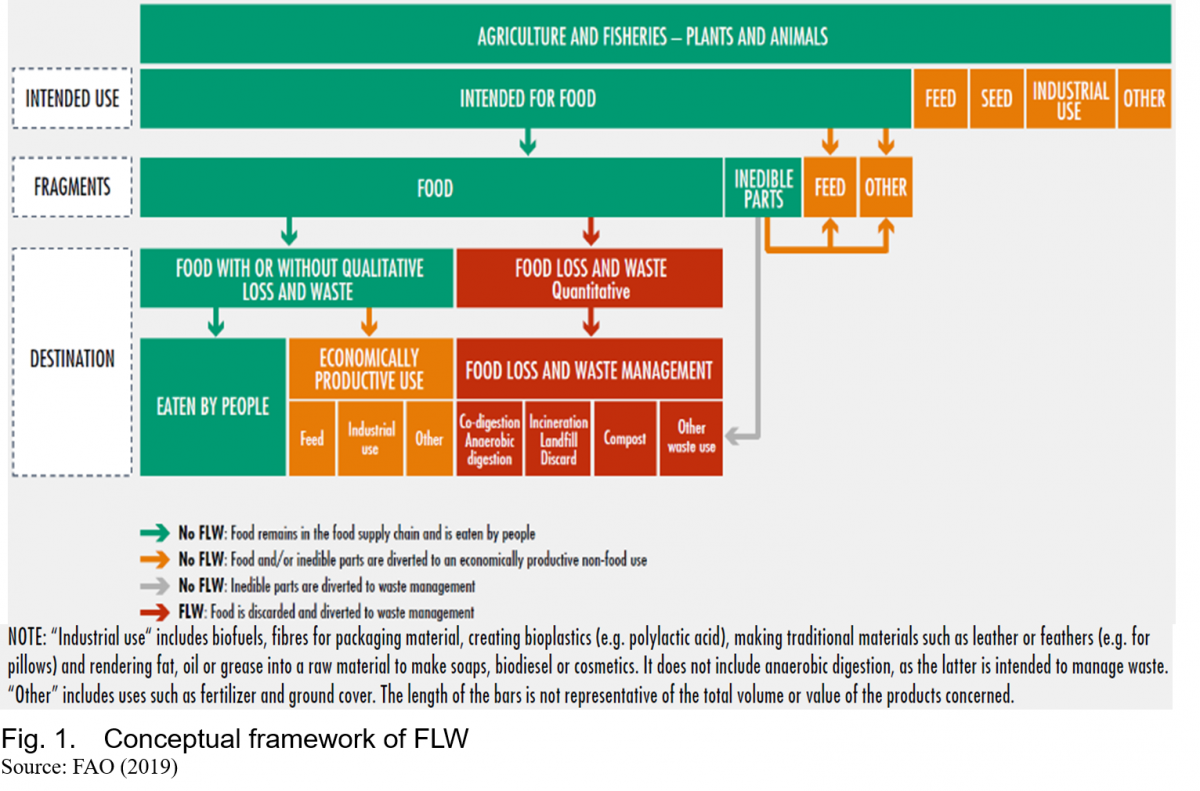
FLW AND SDGs
There are international policy debates with the consensus that FLW reduction will reduce the production cost (using input efficiency), improve food security (increase productivity) and nutrition (and quality) and contribute towards environmental sustainability by decreasing greenhouse gas (GHG) emissions. Minimizing FLW and efficiently utilizing most of resources under the food systems are particularly important to feed world population in the future projected at US$10 billion in 2050.
FLW in agriculture has become a major global issue and is enshrined in SDG 12 (responsible consumption and production) involving the SDG Target 12.3 aimed at the goal that by 2030, food loss in production and post-harvest processes (SDG 12.3.1) and the world per capita food wastes are reduced by half (SDG 12.3.2). Reducing FLW could have wider implications for other SDGs related to the food system, such as SDG 2, dealing with ending hunger and achieving food security and improved nutrition, SDG 6 concerning sustainable water management, SDG 7 (affordable and clean energy), SDG 11 involving sustainable cities and communities, SDG 13 dealing with climate change (reduce GHG emission), and SDG 15 (conserve, restore and sustainably use terrestrial ecosystems and halt deforestation). The potential linkages between reducing food loss and wastes and related various SDGs are described in Fig. 2.
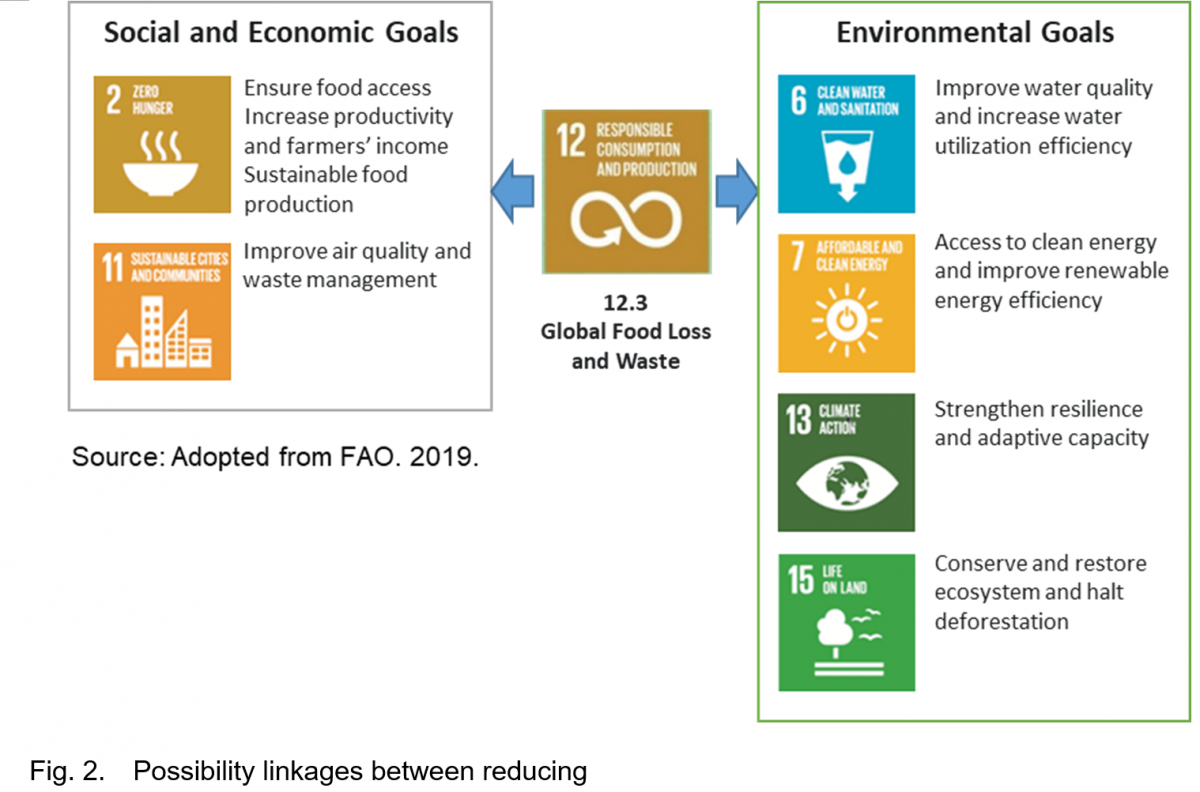
In conclusion from FAO, food loss is classified when it is any food that has been spilled, spoilt, burned or discarded in other ways by the food operators in the chain or incurs reduction of quality and value during its process in the food supply chain before it reaches its final product stage. It typically takes place at production, post-harvest, processing, and distribution stages in the food supply chain, excluding retail activities (as indicated in Fig. 3).
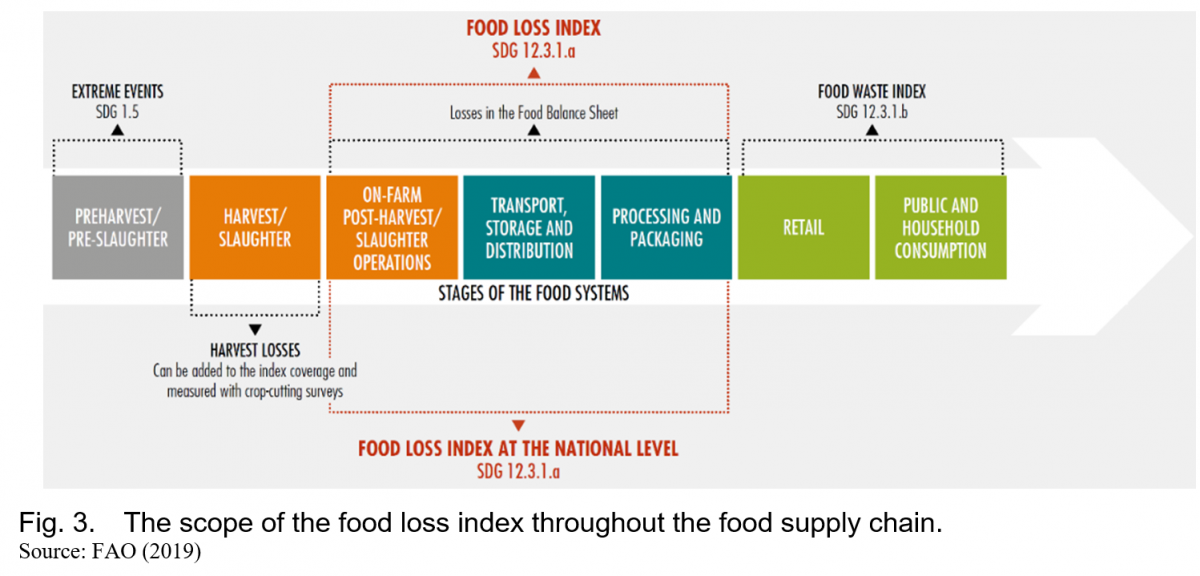
SCOPE OF THE GOOD EXAMPLE: CASSAVA
This study calculated the food loss according to the latest food loss definition established by the Food and Agriculture Organization (FAO, 2019) and cassava had been selected for the study commodity because cassava is considered as one of important economic crops in Thailand with the harvested areas of 8.66 million rai or 2.98 million hectare (1 hectare = 6.25 rais or 1 rai = 0.16 hectares) and a yield of 31.08 million tons in 2019 (Office of Agricultural Economics, 2020), generating income for farmers up to 57.33 billion baht (1.79 billion US$). About 55% of the cassava produced is processed into cassava starch, 40% of modified starch and 5 % of ethanol. (Ministry of Commerce, 2017). In addition, cassava has a high loss rate, and it is related with multi food and nonfood industries (as indicted in Fig. 4).

CIRCULAR ECONOMY BUSINESS PLAN: CASSAVA PROCESSING
The processing of cassava starch extraction is associated with the generation of waste from removing the outer skin of the root as well as the adhering dirt (cassava peel or slag) from the initial processing, and a large volume of liquid wastes are generated from root washing and the entire starch extraction process. The wastes from peeling or dirt can be used for mushroom culture while cassava sludge can be utilized not only for making compost or fertilizers but also biogas generation. Moreover, water wastes from cassava starch plant can be treated and used for plant irrigation and generate biogas. The electricity generation and biofuel produced from biogas have shown an example or representation that can give sustainable opportunities to encouraging or increasing the use of cassava circular economy practices. Furthermore, the residue from starch process which is called cassava waste or cassava cake (in wet) are dried to obtain cassava meal (dried form) and to be utilized as animal feed (as described in Fig. 5).
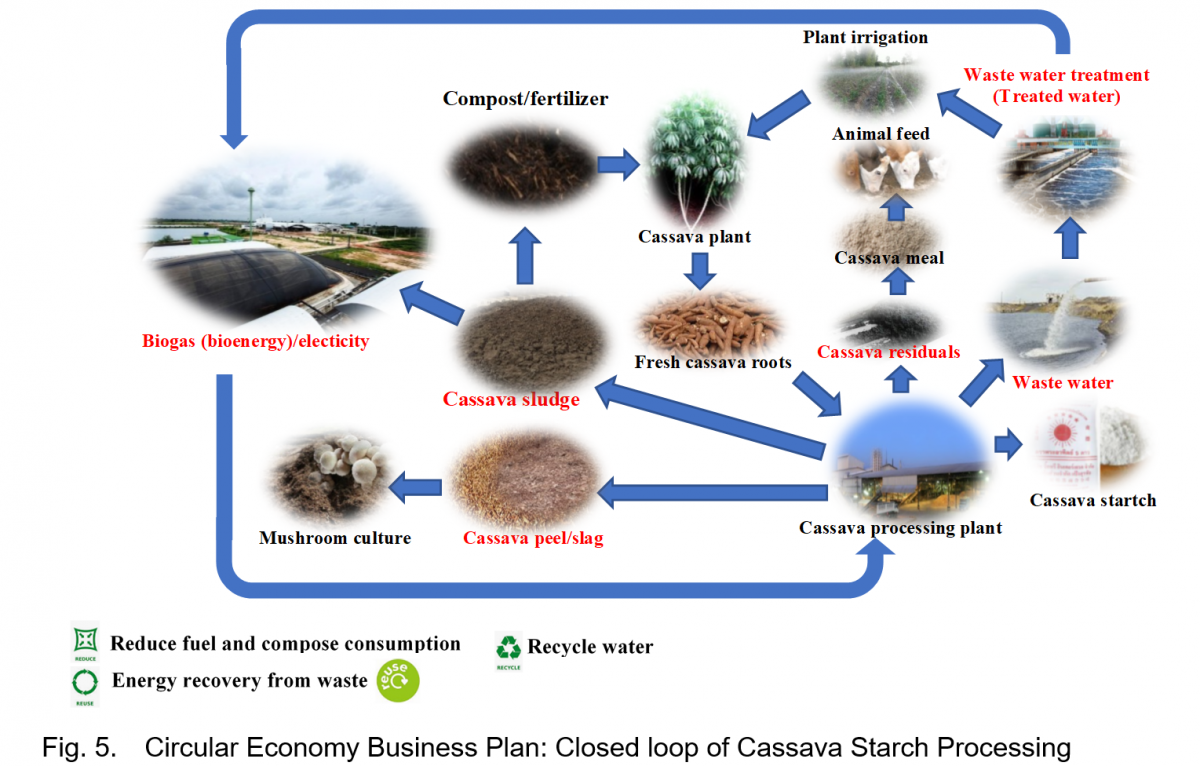
FOOD LOSS REDUCTION A PART OF CE
According to the United Nations Food and Agriculture Organization (FAO), the loss of cassava production at the farm level in Thailand is relatively constant at 5.0% (FAO, 2019). While previous studies such as the study of GIZ (2013) indicted that the physical losses at the farm level of Nigeria cassava production (from harvest onwards) was at 8% and the study of Nasiri et al. (2014) estimated physical loss of cassava, mainly occurred at the farm level and on farm loss, at 1.5% due to breaking the cassava tuber from digging machine or the delay of the collector in collecting the fresh cassava at the farmers' plots. In addition, Seree Wong, Phichet, and Somnuk Chusilp (2005) estimated the loss due to not completely digging up all cassava tubers. The smaller tractor causes more loss about 3.3% while the bigger tractor causes only 0.4 - 0.6%. The loss will be higher for those in the northeastern region, there was a 1- 4% loss of its roots and in the lower northern and upper central regions there was a loss of 2-3%.
ESTIMATES OF FOOD LOSS IN THE STUDY FOR CASSAVA PRODUCTS
In this study, two types of losses were estimated- physical loss and economic loss at each level of the cassava supply chain. “Physical loss” refers to the amount of product that is lost or discarded without being used. Physical losses at the farm level consists of fresh cassava roots that are rotten or damaged by floods, diseases and pests and the amount of fresh cassava left in the plot (not completely digging up), including the amount of fresh cassava that has been lost or spoiled during the transportation from the farm to the cassava starch factory. Physical losses at the transport, processing and distribution levels contain the amount of fresh cassava that perishes because of loading/unloading/cleaning of the tubers before processing. The amount of starch lost in the starch processing and in the transportation and distribution to the destination market. “Economic loss” refers to the economic value of the output that should be obtained but not received due to low quality, resulting in lower prices or lower yields. Economic losses at the farm level consisted of lowering the yield and the lowering percentage of starch content, causing lower price to the farmers. In addition, the prices received by farmers were lower due to impurities attached to fresh cassava. Economic losses at the processing level are concerned with the difference between the price of clean cassava and general cassava price or the price difference between the high-grade flour and low-grade flour.
The concept of loss assessment in cassava, both physical and economic losses and factors affecting the losses at each level of the cassava supply chain in Thailand are summarized in Fig. 6.
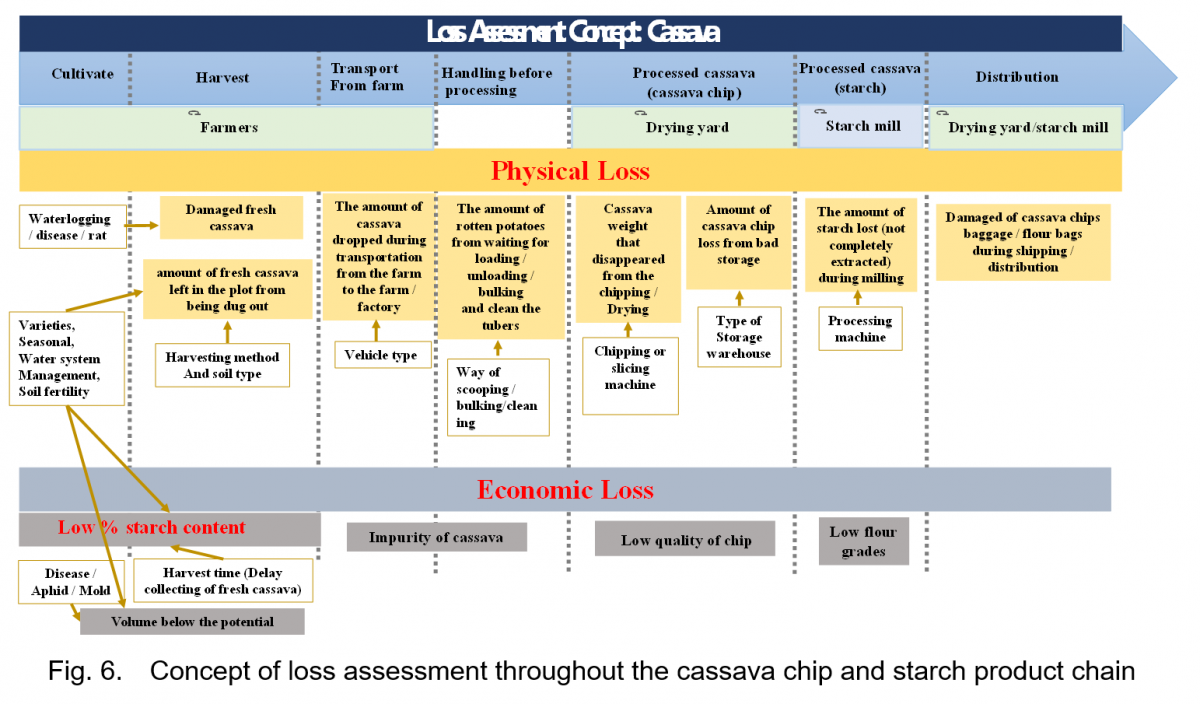
Estimates of physical and economic losses in cassava products can be summarized in Fig.7.
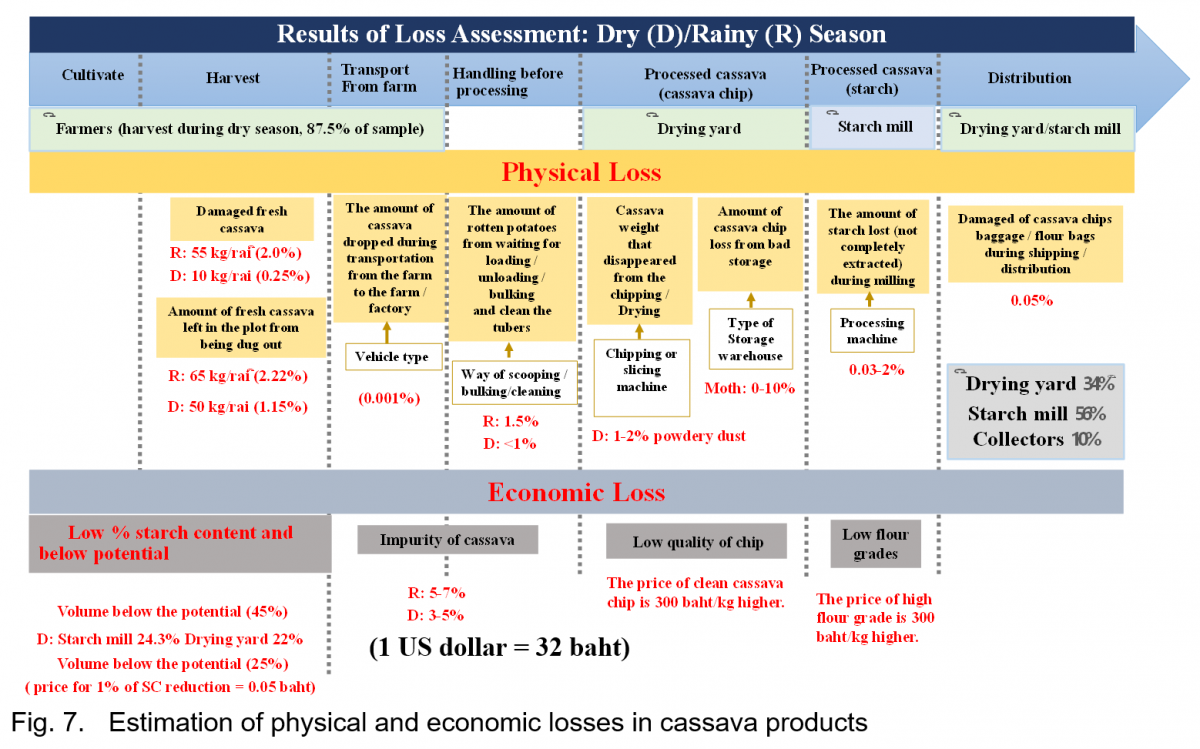
Based on FAO food loss definition, there will be a total food loss of 28.97 kg/1,000 kg of cassava post-harvest or equivalent to the loss value of 70.50 baht/ton (2.2 US$/ton). While the food loss according to the definition of Thailand National Food Board throughout the production supply chain from cultivation to post harvest indicated that there is a physical loss of 62 kg/1,000 kg of pre-harvested produce or can be estimated to be equivalent to the loss value of 148.61 baht/ton (4.64 US$/ton).
In addition, when using the data obtained from this study to estimate total losses nationally, it found that with the total yield of cassava in 2018/19 at 31.08 million tons of fresh cassava root, considering the FAO definition, food loss from fresh cassava root production was 1,212.12 tons, equal to 2,949.24 million baht (92.16 million US$) while based on Thailand National Food Board, the amount of loss was 1,913.39 tons with the value of 4,655.52 million baht (145.46 million US$).
POLICY SOLUTIONS AND RECOMMENDATIONS
Although this is an extremely important issue for decision makers, there are very few potential policy solutions and/or recommendations in the FLW literature (Rutten, 2013; Koester, 2014; Neff et al., 2015):
•The use of taxes and subsidies to decrease wasteful behavior among consumers;
•Financial support, especially in developing countries, to improve roads and energy infrastructure as well as the machinery used;
•Institutional arrangements and reforms to facilitate access of the private sector investment to agricultural production;
•Holistic approach/circular economy approach: focus on the causes of FLW as well as the consequences, regional and country differences; and the stakeholders and actors involved;
•Communication and education campaigns targeted to reduce food waste.
Some of the main challenges to policy development and implementation found were: inconsistencies in terminologies and definitions used; lack of reliable and consistent data; lack of applied research; lack of information on socioeconomic impacts; the need for monitoring and evaluation of existing policies; and the need for a holistic approach to address FLW (Rutten, 2013; Koester, 2014; Neff et al., 2015; Bahadur et al., 2016; Chaboud and Benoit, 2017)
The government sector should provide knowledge and promote the use of certified cassava varieties classified by soil type conditions. It should also provide information on how to do proper farm and harvest management to reduce cassava’s physical loss. The crop should be harvested at the right time to get high percentage of starch content (reduce the economic loss and get higher price).
The government sector should provide knowledge on the use of digging machines with the proper speed of digging tractor to reduce the broken cassava tubers.
CONCLUSIONS
There is a general consensus on the fact that reducing food loss of cassava at the farm level (pre-harvest and harvest) and more holistic approaches of the circular economy by turning waste to environmental and economic value product has a great potential for strengthening sustainability, avoiding economic costs and create economic value for cassava production.
REFERENCES
Buzby et al. 2015. Estimated fresh produce shrink and food loss in US supermarkets Agriculture - mdpi.com
FAO. 2011. Global food losses and food waste – Extent, causes and prevention. Rome, Food and Agriculture Organization of the United Nations. (http://www.fao. org/3/mb060e/mb060e00.htm)
FAO. 2014. Definitional Framework of Food Loss. Working Paper. Rome, Food and Agriculture Organization of the United Nations. (http://www.fao.org/fileadmin/ user_upload/save-food /PDF /FLW_Definition_and_Scope_2014.pdf)
FAO. 2018. Food loss analysis: causes and solutions Case study on the tomato value chain in the Republic of Guyana. Rome, Food and Agriculture Organization of the United Nations. (http://www.fao.org/3/I9610EN/ i9610en.pdf)
FAO. 2019. The state of food and agriculture. Moving forward on food loss and waste reduction. Rome, Food and Agriculture Organization of the United Nations. (http://www.fao.org/3/ca6030en /ca6030en.pdf)
HLPE. 2014. Food losses and waste in the context of sustainable food systems. A report by the High Level Panel of Experts on Food Security and Nutrition of the Committee on World Food Security, Rome.
Kummu et al. 2012. Lost food, wasted resources: Global food supply chain losses and their impacts on freshwater, cropland, and fertilizer use. Science of The total Environment 438, 477-489.
Parfitt, Barthel and Macnaughton. 2010. Food waste within food supply chains: quantification and potential for change to 2050. (https://doi.org/ 10.1098/rstb.2010.0126)


Food Loss and Waste Reduction as Part of Circular Economy: A Case of Cassava in Thailand
ABSTRACT
Based on a case study of cassava analysis, this study described food loss along the cassava supply chain. Overall food loss in Thailand at the processing level was very limited. In addition, the electricity generation and biofuel produced from biogas from the cassava and starch factory have shown a good example of circular economy practice. However, physical loss mainly occurred at farm level and on farm loss due to breaking the cassava tuber from digging machine or the delay of collecting the fresh cassava root at the farmers' plots causing damaged of fresh cassava root. Despite, in the cassava starch processing it generated a large volume of waste from peeling and adhering dirt from the initial processing, and a large volume of liquid wastes from root washing and starch extraction process. The cost of treatment and disposal of these wastes and residues bring a huge financial burden to the cassava starch processing factory. Therefore, turning waste to environmental and economic value product can make the cassava starch processing plant to be sustainably and create economic value. In addition, the electricity generation and biofuel produced from biogas have shown a representativeness and are sustainable opportunities to encouraging or increasing the use of cassava circular economy practices.
Keywords: Food Loss, Circular Economy, Cassava, Thailand
INTRODUCTION
From the past to the present, the world population has been growing steadily and, in the future, it is projected to increase from approximately 7.6 billion in 2017 to 8.6 billion in 2030 and to 9.8 billion in 2050 (United Nations, 2017). Due to the rise of the world population, coupled with a forecast of global economic growth of 2.9 % per year, the forecast is that the world will have to produce more than 70 % of food in 2050 (FAO, 2019). Although technology has made great advances and helped the world to produce more food; however, according to global food loss and waste (FLW) study of FAO, it is founded that about one-third of the world’s food produced for human consumption is lost and wasted globally, which amounts to 1.3 billion tons per annum. The high-income countries and the middle to low income countries account for 670 and 630 million tons of food wastes and disposed per annum, respectively. Based on existing data and peer-reviewed literature also showed that FLW has the related environmental, social and economic impacts and the scale of FLW throughout the food value chain is analyzed from agricultural production down to household consumption and disposal. Food loss and waste in economic context represents a waste of resources used in each production stage, and it also contributes to unnecessary increase of greenhouse gas (GHG) emissions. FAO indicated that FLW generated GHG of 3.3 gigatons of carbon dioxide equivalent (FAO, 2014). This food wastage and disposal will not only lead to undermine the sufficiency of food for the world population in the future but also has a negative impact on the limited resource utilization for food production and environment.
The Food and Agriculture Organization (FAO) of the United Nations estimates that more than 40 % of all food losses in developing countries occur in food production period (Pre-Harvest Level), the post-harvest period (Post-Harvest Level) and in processing (Processing Level) while in developed countries, food wastage often occurs during retail and when food reaches consumers (FAO, 2011; 2019). In Southeast Asia, the Institution of Mechanical Engineers (2013) estimated that losses from rice production could be as high as 37-60%. While the study of Parfitt, Barthel and Macnaughton (2010) indicated that the minimum waste from rice production in Asia is between 13% and15%. For fruits and vegetables, FAO found that losses in developing countries, including Southeast Asia, are most likely to occur in pre-harvest and post-harvest production, accounting for 16 % and 19 %, respectively. Throughout the food chain of fruits and vegetables, more than 50 % of the total loss of the product had been produced (FAO, 2011). In Thailand, the Office of Agricultural Economics (2015) analyzed food wastage and discarding of fresh vegetables and found that there was 15% loss before harvest, 9% loss of post-harvest, and 25% loss of processing and packaging during distribution and trade. Kummu et al. (2012) estimates that an estimated 1 billion people who are starving will consume more food if our planet can reduce half of food crop production loss.
This paper provides insights into key concepts around FLW of cassava and highlights the scale of the problem at a farm and regional level. It also reflects on the main challenges for implementing strategies to reduce FL and the implications for policymaking.
DEFFINITIONS OF FLW IN AGRICULTURE
The terms “food loss” and “food waste” are commonly used to describe total losses and waste within the different steps of the food supply chain (FSC) from production (pre-harvest), postharvest, processing to distribution and consumption. However, there is no single definition of food loss (FL) and food waste (FW). Various stakeholders in global food systems use many definitions and terminologies due to different goals for quantifying FLW (HLPE, 2014, Buzby et al., 2015; Food and Agriculture Organization, 2015). Terminologies of FLW can be diversified in terms of scope (intended for human consumption or not), timing (pre-harvested, harvesting, post-harvested), criterion (utilization, edibility or nutrition), perspective (environmental, social, food security), and type (quality or quantity of food) (Lundqvist, de Fraiture et al. (2008), BCFN (2012), Chaboud and Benoit (2017). Food and Agriculture Organization (2019) defined FL as the decrease in the quantity or quality of food caused by the decisions and actions of food operators throughout the food supply chain from harvesting/slaughter/capture to retail level, not including the retailer food service providers and consumers.
FLW in agriculture can be described as total loss from plant and livestock production in terms of quantity and quality of the products or plant and livestock that was never harvested and planted and livestock that was lost during harvest (production or pre-harvested level) to post-harvest loss which refers to the quantitative and qualitative as measured in the postharvest system during transportation and distribution to retailers for sale (Schneider (2008), Hodges (2011), Gunders (2012))
CONCEPTUAL FRAMEWORK OF FLW
The conceptual framework in Fig. 1 distinguishes between the intended use of plants and animals for both food and nonfood. Intended food can be separated according to edible (food) and inedible parts used for animal feeds or other uses (industrial uses).
FLW AND SDGs
There are international policy debates with the consensus that FLW reduction will reduce the production cost (using input efficiency), improve food security (increase productivity) and nutrition (and quality) and contribute towards environmental sustainability by decreasing greenhouse gas (GHG) emissions. Minimizing FLW and efficiently utilizing most of resources under the food systems are particularly important to feed world population in the future projected at US$10 billion in 2050.
FLW in agriculture has become a major global issue and is enshrined in SDG 12 (responsible consumption and production) involving the SDG Target 12.3 aimed at the goal that by 2030, food loss in production and post-harvest processes (SDG 12.3.1) and the world per capita food wastes are reduced by half (SDG 12.3.2). Reducing FLW could have wider implications for other SDGs related to the food system, such as SDG 2, dealing with ending hunger and achieving food security and improved nutrition, SDG 6 concerning sustainable water management, SDG 7 (affordable and clean energy), SDG 11 involving sustainable cities and communities, SDG 13 dealing with climate change (reduce GHG emission), and SDG 15 (conserve, restore and sustainably use terrestrial ecosystems and halt deforestation). The potential linkages between reducing food loss and wastes and related various SDGs are described in Fig. 2.
In conclusion from FAO, food loss is classified when it is any food that has been spilled, spoilt, burned or discarded in other ways by the food operators in the chain or incurs reduction of quality and value during its process in the food supply chain before it reaches its final product stage. It typically takes place at production, post-harvest, processing, and distribution stages in the food supply chain, excluding retail activities (as indicated in Fig. 3).
SCOPE OF THE GOOD EXAMPLE: CASSAVA
This study calculated the food loss according to the latest food loss definition established by the Food and Agriculture Organization (FAO, 2019) and cassava had been selected for the study commodity because cassava is considered as one of important economic crops in Thailand with the harvested areas of 8.66 million rai or 2.98 million hectare (1 hectare = 6.25 rais or 1 rai = 0.16 hectares) and a yield of 31.08 million tons in 2019 (Office of Agricultural Economics, 2020), generating income for farmers up to 57.33 billion baht (1.79 billion US$). About 55% of the cassava produced is processed into cassava starch, 40% of modified starch and 5 % of ethanol. (Ministry of Commerce, 2017). In addition, cassava has a high loss rate, and it is related with multi food and nonfood industries (as indicted in Fig. 4).
CIRCULAR ECONOMY BUSINESS PLAN: CASSAVA PROCESSING
The processing of cassava starch extraction is associated with the generation of waste from removing the outer skin of the root as well as the adhering dirt (cassava peel or slag) from the initial processing, and a large volume of liquid wastes are generated from root washing and the entire starch extraction process. The wastes from peeling or dirt can be used for mushroom culture while cassava sludge can be utilized not only for making compost or fertilizers but also biogas generation. Moreover, water wastes from cassava starch plant can be treated and used for plant irrigation and generate biogas. The electricity generation and biofuel produced from biogas have shown an example or representation that can give sustainable opportunities to encouraging or increasing the use of cassava circular economy practices. Furthermore, the residue from starch process which is called cassava waste or cassava cake (in wet) are dried to obtain cassava meal (dried form) and to be utilized as animal feed (as described in Fig. 5).
FOOD LOSS REDUCTION A PART OF CE
According to the United Nations Food and Agriculture Organization (FAO), the loss of cassava production at the farm level in Thailand is relatively constant at 5.0% (FAO, 2019). While previous studies such as the study of GIZ (2013) indicted that the physical losses at the farm level of Nigeria cassava production (from harvest onwards) was at 8% and the study of Nasiri et al. (2014) estimated physical loss of cassava, mainly occurred at the farm level and on farm loss, at 1.5% due to breaking the cassava tuber from digging machine or the delay of the collector in collecting the fresh cassava at the farmers' plots. In addition, Seree Wong, Phichet, and Somnuk Chusilp (2005) estimated the loss due to not completely digging up all cassava tubers. The smaller tractor causes more loss about 3.3% while the bigger tractor causes only 0.4 - 0.6%. The loss will be higher for those in the northeastern region, there was a 1- 4% loss of its roots and in the lower northern and upper central regions there was a loss of 2-3%.
ESTIMATES OF FOOD LOSS IN THE STUDY FOR CASSAVA PRODUCTS
In this study, two types of losses were estimated- physical loss and economic loss at each level of the cassava supply chain. “Physical loss” refers to the amount of product that is lost or discarded without being used. Physical losses at the farm level consists of fresh cassava roots that are rotten or damaged by floods, diseases and pests and the amount of fresh cassava left in the plot (not completely digging up), including the amount of fresh cassava that has been lost or spoiled during the transportation from the farm to the cassava starch factory. Physical losses at the transport, processing and distribution levels contain the amount of fresh cassava that perishes because of loading/unloading/cleaning of the tubers before processing. The amount of starch lost in the starch processing and in the transportation and distribution to the destination market. “Economic loss” refers to the economic value of the output that should be obtained but not received due to low quality, resulting in lower prices or lower yields. Economic losses at the farm level consisted of lowering the yield and the lowering percentage of starch content, causing lower price to the farmers. In addition, the prices received by farmers were lower due to impurities attached to fresh cassava. Economic losses at the processing level are concerned with the difference between the price of clean cassava and general cassava price or the price difference between the high-grade flour and low-grade flour.
The concept of loss assessment in cassava, both physical and economic losses and factors affecting the losses at each level of the cassava supply chain in Thailand are summarized in Fig. 6.
Estimates of physical and economic losses in cassava products can be summarized in Fig.7.
Based on FAO food loss definition, there will be a total food loss of 28.97 kg/1,000 kg of cassava post-harvest or equivalent to the loss value of 70.50 baht/ton (2.2 US$/ton). While the food loss according to the definition of Thailand National Food Board throughout the production supply chain from cultivation to post harvest indicated that there is a physical loss of 62 kg/1,000 kg of pre-harvested produce or can be estimated to be equivalent to the loss value of 148.61 baht/ton (4.64 US$/ton).
In addition, when using the data obtained from this study to estimate total losses nationally, it found that with the total yield of cassava in 2018/19 at 31.08 million tons of fresh cassava root, considering the FAO definition, food loss from fresh cassava root production was 1,212.12 tons, equal to 2,949.24 million baht (92.16 million US$) while based on Thailand National Food Board, the amount of loss was 1,913.39 tons with the value of 4,655.52 million baht (145.46 million US$).
POLICY SOLUTIONS AND RECOMMENDATIONS
Although this is an extremely important issue for decision makers, there are very few potential policy solutions and/or recommendations in the FLW literature (Rutten, 2013; Koester, 2014; Neff et al., 2015):
•The use of taxes and subsidies to decrease wasteful behavior among consumers;
•Financial support, especially in developing countries, to improve roads and energy infrastructure as well as the machinery used;
•Institutional arrangements and reforms to facilitate access of the private sector investment to agricultural production;
•Holistic approach/circular economy approach: focus on the causes of FLW as well as the consequences, regional and country differences; and the stakeholders and actors involved;
•Communication and education campaigns targeted to reduce food waste.
Some of the main challenges to policy development and implementation found were: inconsistencies in terminologies and definitions used; lack of reliable and consistent data; lack of applied research; lack of information on socioeconomic impacts; the need for monitoring and evaluation of existing policies; and the need for a holistic approach to address FLW (Rutten, 2013; Koester, 2014; Neff et al., 2015; Bahadur et al., 2016; Chaboud and Benoit, 2017)
The government sector should provide knowledge and promote the use of certified cassava varieties classified by soil type conditions. It should also provide information on how to do proper farm and harvest management to reduce cassava’s physical loss. The crop should be harvested at the right time to get high percentage of starch content (reduce the economic loss and get higher price).
The government sector should provide knowledge on the use of digging machines with the proper speed of digging tractor to reduce the broken cassava tubers.
CONCLUSIONS
There is a general consensus on the fact that reducing food loss of cassava at the farm level (pre-harvest and harvest) and more holistic approaches of the circular economy by turning waste to environmental and economic value product has a great potential for strengthening sustainability, avoiding economic costs and create economic value for cassava production.
REFERENCES
Buzby et al. 2015. Estimated fresh produce shrink and food loss in US supermarkets Agriculture - mdpi.com
FAO. 2011. Global food losses and food waste – Extent, causes and prevention. Rome, Food and Agriculture Organization of the United Nations. (http://www.fao. org/3/mb060e/mb060e00.htm)
FAO. 2014. Definitional Framework of Food Loss. Working Paper. Rome, Food and Agriculture Organization of the United Nations. (http://www.fao.org/fileadmin/ user_upload/save-food /PDF /FLW_Definition_and_Scope_2014.pdf)
FAO. 2018. Food loss analysis: causes and solutions Case study on the tomato value chain in the Republic of Guyana. Rome, Food and Agriculture Organization of the United Nations. (http://www.fao.org/3/I9610EN/ i9610en.pdf)
FAO. 2019. The state of food and agriculture. Moving forward on food loss and waste reduction. Rome, Food and Agriculture Organization of the United Nations. (http://www.fao.org/3/ca6030en /ca6030en.pdf)
HLPE. 2014. Food losses and waste in the context of sustainable food systems. A report by the High Level Panel of Experts on Food Security and Nutrition of the Committee on World Food Security, Rome.
Kummu et al. 2012. Lost food, wasted resources: Global food supply chain losses and their impacts on freshwater, cropland, and fertilizer use. Science of The total Environment 438, 477-489.
Parfitt, Barthel and Macnaughton. 2010. Food waste within food supply chains: quantification and potential for change to 2050. (https://doi.org/ 10.1098/rstb.2010.0126)